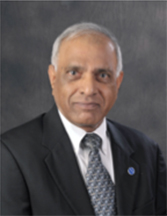Seminars
Prof. J.N. Reddy
Department of Mechanical Engineering
Texas A&M University
Computational Approaches for Architected Materials and Fracture

ABSTRACT: The lecture will present the speaker’s recent research in nonlocal approaches for modeling architected materials and structures [1] and a graph-based finite element analysis (GraFEA) of fracture [2-4]. The non-local continuum models that account for material and/or structural length scales are discussed to model architected materials and structures (e.g., web-core sandwich panels). GraFEA is built upon the fact that the finite element formulation for any hyperelastic continuum can be written in terms of the forces and strains along the edges of the elements. The major difference between GraFEA and continuum-based approaches to study fracture is that instead of placing the focus on the elements and introducing a displacement discontinuity either between or inside the elements, GraFEA focuses on nodes and the distance between the nodes. Fracture is merely introduced by breakage of the edges (any link between any two distinct nodes). Consequently, it will not suffer from the drawbacks of the existing continuum-based methods in the study of fracture. Use of the GraFEA to study fracture in solids is found to be very robust and accurate in predicting fracture. The approach has the ability to model discrete microcracking with random crack orientations. The usefulness of these approaches will be demonstrated using several nontrivial examples.
References
- Anssi Karttunen, J.N. Reddy, and Jani Romanoff, Int. J. Solids and Structures, 170, 82-94, 2019.
- P. Khodabakhshi, J.N. Reddy, and A.R. Srinivasa, Acta Mechanica, 51 (12), 3129-3147, 2019.
- Prakash Thamburaja, K. Sarah, A.R. Srinivasa, and J.N. Reddy, Computer Methods in Applied Mechanics and Engineering, 354, 871-903, 2019.
- K. Sarah, P. Thamburaja, A. Srinivasa, and J. N. Reddy, Mechanics of Advanced Materials and Structures, 27(13), 1085-1097, 2020.
BIOGRAPHY: Dr. Reddy is a Distinguished Professor, Regents’ Professor, and the holder of the O’Donnell Foundation Chair IV in Mechanical Engineering at Texas A&M University, College Station, Texas. Dr. Reddy, an ISI highly-cited researcher, is known for his significant contributions to the field of applied mechanics through the authorship of a large number of textbooks and journal papers. His pioneering works on the development of shear deformation theories (that bear his name in the literature as the Reddy third-order plate theory and the Reddy layerwise theory) have had a major impact and have led to new research developments and applications. Some of the ideas on shear deformation theories and penalty finite element models of fluid flows have been implemented into commercial finite element computer programs like ABAQUS, NISA, and HyperXtrude. In recent years, Reddy's research has focused on the development of locking-free shell finite elements and nonlocal and non-classical continuum mechanics problems, involving couple stresses, surface stress effects, micropolar cohesive damage, and continuum plasticity of metals.
Dr. Reddy has received numerous honors and awards. The most recent ones include: the 2022 IACM Congress (Gauss-Newton) Medal from the International Association of Computational Mechanics, the 2019 SP Timoshenko Medal from the American Society of Mechanical Engineers, the 2018 Theodore von Karman Medal from the American Society of Civil Engineers, the 2017 John von Neumann Medal from the U.S. Association of Computational Mechanics, the 2016 Prager Medal from the Society of Engineering Science, and the 2016 ASME Medal from the American Society of Mechanical Engineers. He is a member of eight national academies, including the US National Academy of Engineering, and foreign fellow of the Indian National Academy of Engineering, the Canadian Academy of Engineering, the Brazilian National Academy of Engineering, the Chinese Academy of Engineering, the Royal Engineering Academy of Spain, the European Academy of Sciences, and the European Academy of Sciences and Arts.